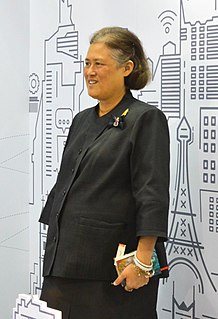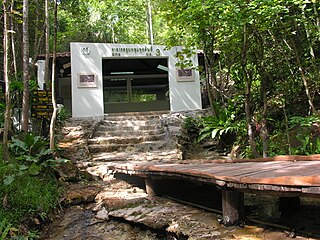Bruhathkayosaurus is an extinct genus of sauropod dinosaur found in the Kallemedu Formation of India. The fragmentary remains were originally described as a theropod but later publications listed it as a sauropod. Estimates by researchers exceed those of the titanosaur Argentinosaurus, as longer than 35 metres (115 ft) and weighing over 80 tons. All the estimates are based on the dimensions of the fossils described in Yadagiri and Ayyasami's 1987 paper, which announced the find. In 2017 it was reported that the original fossils had disintegrated and no longer exist.

The Morrison Formation is a distinctive sequence of Upper Jurassic sedimentary rock found in the western United States which has been the most fertile source of dinosaur fossils in North America. It is composed of mudstone, sandstone, siltstone, and limestone and is light gray, greenish gray, or red. Most of the fossils occur in the green siltstone beds and lower sandstones, relics of the rivers and floodplains of the Jurassic period.

Princess Maha Chakri Sirindhorn, formerly Princess Sirindhorn Debaratanasuda Kitivadhanadulsobhak, is the second daughter of King Bhumibol Adulyadej and younger sister of King Vajiralongkorn.

Isanosaurus was a sauropod dinosaur from Thailand. It was originally dated to approximately 210 million years ago during the Late Triassic, which would make it one of the oldest known sauropods. Its age was later considered uncertain, and may be as young as Late Jurassic. The only species is Isanosaurus attavipachi. Though important for the understanding of sauropod origin and early evolution, Isanosaurus is poorly known. Exact relationships to other early sauropods remain unresolved.

Siamotyrannus is a genus of carnivorous theropod dinosaur from the early Cretaceous of Thailand.

Siamosaurus is a genus of spinosaurid dinosaur that lived in what is now Thailand during the Early Cretaceous period and is the first reported spinosaurid from Asia. It is confidently known only from tooth fossils; the first were found in the Sao Khua Formation, with more teeth later recovered from the younger Khok Kruat Formation. The type species Siamosaurus suteethorni, whose name honours Thai palaeontologist Varavudh Suteethorn, was formally described in 1986. In 2009, four teeth from China previously attributed to a pliosaur—under the species "Sinopliosaurus" fusuiensis—were identified as those of a spinosaurid, possibly Siamosaurus. It is yet to be determined if two partial spinosaurid skeletons from Thailand and an isolated tooth from Japan also belong to Siamosaurus.

Kinnareemimus is a genus of ornithomimosaurian theropod dinosaur from Thailand. It is known only from incomplete remains including vertebrae, partial pubic bones, metatarsals, and an incomplete fibula. The third metatarsal exhibits a distinctive lateral "pinching", known as the "arctometarsalian" condition, variations of which are found in ornithomimosaurs, tyrannosauroids, troodontids, and caenagnathids. Its remains were collected from the Early Cretaceous Sao Khua Formation, dating to the Barremian stage, at Phu Wiang, Khon Kaen Province. Its early occurrence makes it among the earliest ornithomimosaur known, depending on the age of the formation. Buffetaut et al. suggest the fossils of Kinnareemimus may indicate an Asian origin for advanced ornithomimosaurs.

Phuwiangosaurus is a genus of titanosauriform dinosaur from the Early Cretaceous (Valanginian-Hauterivian) Sao Khua Formation of Thailand. The type species, P. sirindhornae, was described by Martin, Buffetaut, and Suteethorn in a 1993 press release and was formally named in 1994. The species was named to honor Princess Maha Chakri Sirindhorn of Thailand, who was interested in the geology and palaeontology of Thailand, while the genus was named after the Phu Wiang area, where the fossil was discovered.

Wiang Kao is a district (amphoe) of Khon Kaen Province, northeastern Thailand.

Nong Na Kham is a district (amphoe) of Khon Kaen Province, northeastern Thailand.

Phu Wiang is a district (amphoe) in the northwestern part of Khon Kaen Province, northeastern Thailand.

Phu Wiang Dinosaur Museum is a geological museum mainly exhibiting fossils. It is under the administration of the Department of Mineral Resources, Ministry of Natural Resources and Environment, of the Royal Thai Government, and situated in the Khok Sanambin public area in Tambon Nai Muang, Wiang Kao district, Khon Kaen province in the northeastern region of Thailand. The museum was constructed with a budget from the Tourism Authority of Thailand (TAT) under the supervision of the Department of Mineral Resources and comprises an area of 40 acres (160,000 m2). It has been open to the public since 2009.

Phu Wiang National Park (PWNP) is in Khon Kaen Province, northeastern Thailand, covering the area of the Phu Wiang Mountains. It is best known for its numerous dinosaur bone paleontological sites, The park is one of the world's largest dinosaur graveyards. In 1996, the remains of Siamotyrannus isanensis, a new family of carnivorous thunder lizards, were unearthed in the park.

Paleontology in New Mexico refers to paleontological research occurring within or conducted by people from the U.S. state of New Mexico. The fossil record of New Mexico is exceptionally complete and spans almost the entire stratigraphic column. More than 3,300 different kinds of fossil organisms have been found in the state. Of these more than 700 of these were new to science and more than 100 of those were type species for new genera. During the early Paleozoic, southern and western New Mexico were submerged by a warm shallow sea that would come to be home to creatures including brachiopods, bryozoans, cartilaginous fishes, corals, graptolites, nautiloids, placoderms, and trilobites. During the Ordovician the state was home to algal reefs up to 300 feet high. During the Carboniferous, a richly vegetated island chain emerged from the local sea. Coral reefs formed in the state's seas while terrestrial regions of the state dried and were home to sand dunes. Local wildlife included Edaphosaurus, Ophiacodon, and Sphenacodon.

Sirindhorna is a genus of hadrosauroid ornithopod dinosaur from Early Cretaceous deposits of northeastern Thailand.

Sirindhorn Museum is a geology museum in northeast Thailand. It is located at Non Buri, Sahatsakhan district, Kalasin province.
Varavudh Suteethorn, or Warawut Suteethorn is a Thai geologist and palaeontologist. He is the current director of the Palaeontological Research and Education Centre, Mahasarakham University. He is best known for his work on vertebrate palaeontology in northeastern Thailand, having contributed to the discovery of many fossil taxa and dig sites in the Khorat Plateau, as a part of a long-standing collaboration between Thai and French scientists.
The Asia Dinosaur Association (ADA) is a professional organization that established in 2013 to advance research, education, and culture related to Asian dinosaurs. The secretary office is settled in Fukui Prefectural Dinosaur Museum.
Phu Wiang is a short, relatively isolated mountain range in the Khorat Plateau of Northeastern Thailand, today within the area of Khon Kaen Province. It is best known as the site of the discovery of dinosaur fossils in Thailand, and is also home to ancient human settlements. The mountain, most of which is designated as Phu Wiang National Park, has two arms extending in a horseshoe shape, almost encircling a wide valley which is home to what used to be the old population centre of Phu Wiang District. In 2007, the valley area, which covers the old town as well as the paleontological digs and Phu Wiang Dinosaur Museum, was split off to form Wiang Kao District.















